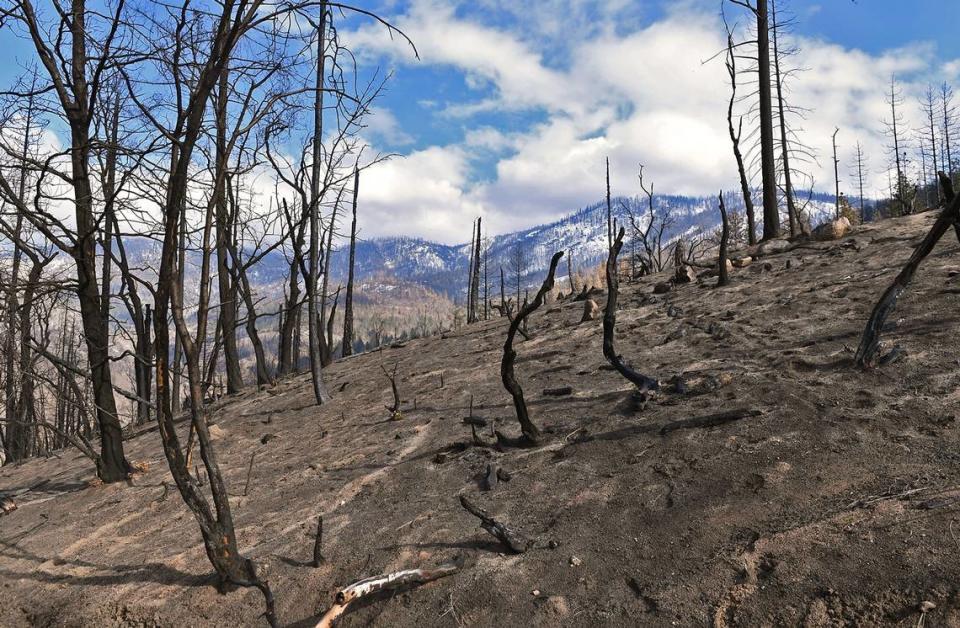Creek Fire caused by pot growers? Forest Service says no, but citizen sleuths find clues
As far as the authorities are concerned, the investigation into what caused the 2020 Creek Fire that burned nearly 380,000 acres of the Sierra National Forest northeast of Fresno is closed.
In its official report issued last July, the U.S. Forest Service declared lightning as the probable cause but left plenty of wiggle room. Just in case additional information or evidence comes to light that, as the heavily redacted 31-page document states, “may result in a change of this conclusion.”
Over the last six months, however, Forest Service officials were offered evidence collected near the origin zone that, along with a rudimentary photo analysis, appears to contradict their official findings. Evidence that lends even greater credence to the long-held belief of an illegal marijuana garden in Big Creek Canyon in the months leading up to the fire — something the Report of Investigation specifically ruled out as a potential cause.
How did Forest Service investigators, and subsequently the Fresno County Sheriff’s Office, react when presented this evidence found by citizen sleuths with long-standing ties to the Shaver Lake area?
Initially with great interest and a little cooperation, followed by a stone wall of silence.
Opinion
“The whole time people kept telling us they’d investigate if we came up with some solid evidence,” said Jeff Young, a fourth-generation Fresno County mountain resident currently living in Montana. “But when we did, everybody ran away from it like it was monkeypox.”
Young has long suspected the Creek Fire’s cause is related to a pot grow. He began emailing me about that possibility shortly after the fire broke out over Labor Day weekend in 2020 and soon expanded his list of correspondents to include Forest Service officials and elected representatives of Fresno County. (I am often cc’ed on Young’s emails.)
A retired logger and lumber mill operator whose property and some personal belongings burned in the Creek Fire, Young has visited the origin zone numerous times on foot and spent hundreds of hours on the computer and making phone calls to an array of contacts. Lifelong Pine Ridge resident Ty Gillette, who lost both his home and business (Cressman’s General Store) to the flames, is also among those investigating. Young and Gillette share information.
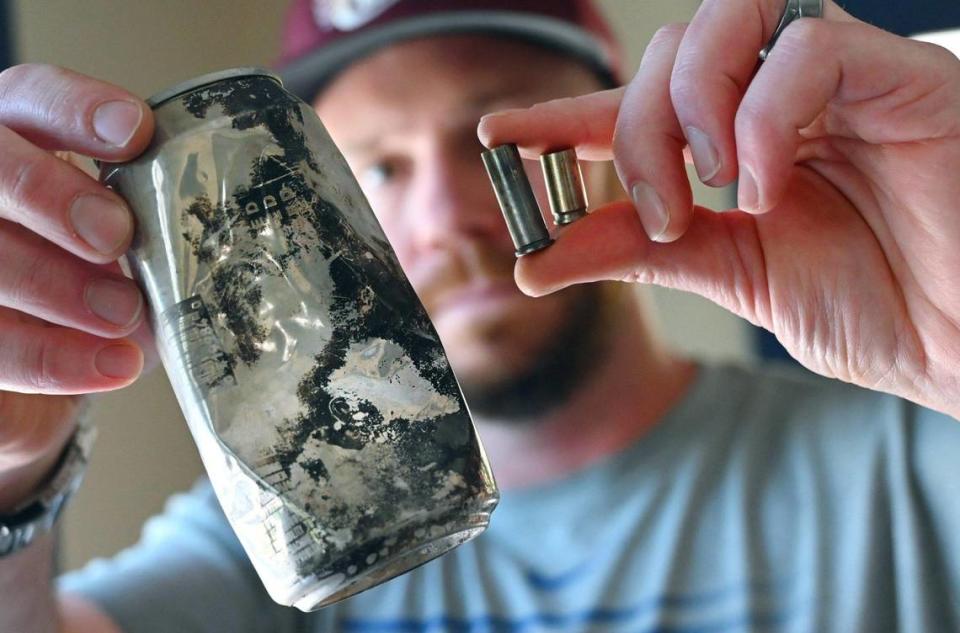
“We’re just trying to get closer to the truth about this fire that caused so much devastation and destroyed so many of my friends’ and family’s homes,” Gillette said. “There are too many inconsistencies in the Forest Service’s investigation to just let it go.”
“I keep looking for information that contradicts my suspicions,” Young said. “Instead, everything I’ve found contradicts what they say happened.”
No proof Creek Fire caused by lightning
What the Forest Service says happened — make that probably happened — is that a lightning strike caused the Creek Fire. Investigators even zeroed in on the specific tree snag they believe got struck: a dead Douglas fir that had to be felled because of the danger it posed to agency personnel.
The Douglas fir tree in question is, in fact, visible in photographs taken by Big Creek residents during the fire’s initial hours. In photos the tree looks like a giant “candlestick” — a description used by the Forest Service fire engine captain first to arrive on scene.
However, the report doesn’t provide any proof the tree snag in question was actually struck by lightning. Nor does it offer up any lightning strike data within the vicinity. According to the report, the “most likely” lightning activity believed responsible for the fire occurred 15 miles away in the early morning hours of Aug. 24 — 11 days before it was reported.
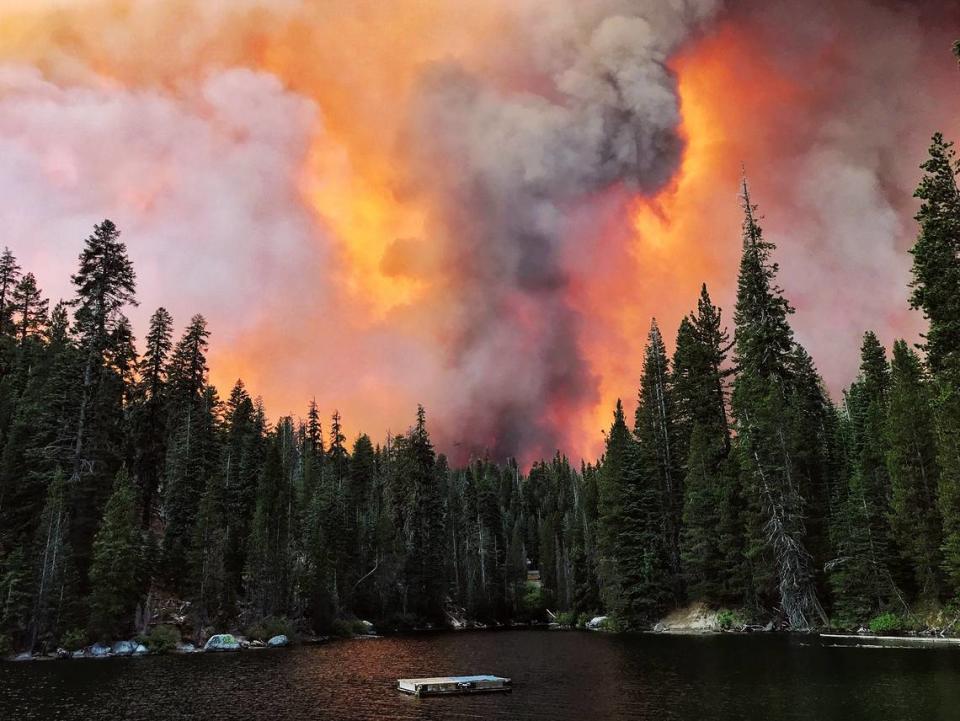
While it’s possible for a fire to smolder for a while before bursting into flames, the chances of that happening in Big Creek Canyon (a place famous for updraft winds) and the smoke going undetected by Big Creek residents or Southern California Edison employees seems highly unlikely.
Furthermore, the Forest Service report excludes a marijuana garden as a potential cause. Why? Chiefly because investigators hiked several drainages around the origin zone and “did not observe any recent signs of cultivation activity.”
That only goes to show investigators didn’t search hard enough. Because some 300 feet straight down the hill from the Douglas fir supposedly struck by lightning, Young and another local (on separate occasions in early 2021) discovered a small campfire circle near the confluence of two creeks.
Inside the campfire circle, they found a Coors Light can, a porcelain dinner plate and the spent casings of several types of bullets. Young initially left those items in the ground, hoping investigators would come across them as well. But in August 2021, after the Forest Service issued its findings, Young and Gillette went back to the site and removed the beer can, plate and two casings (one from a 9 mm pistol, the other from a .38 special) for safekeeping.
The Coors Light can was blackened and faded. But when held at just the right light, a best-buy date of December 2020 is barely perceptible. More legible is the production code printed on the bottom.
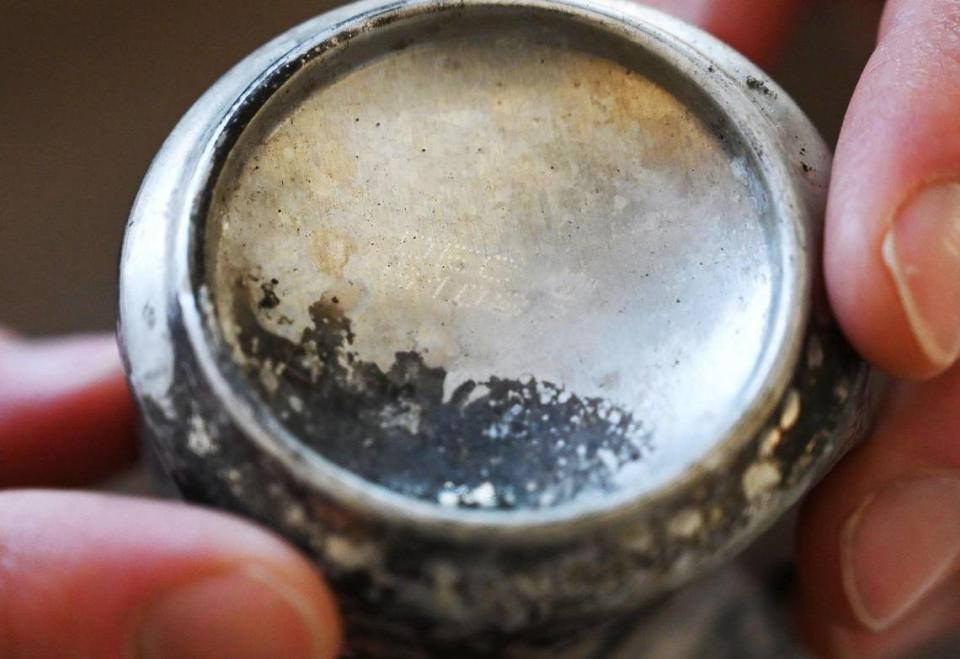
Using Molson Golden’s “How to Read Code Dates” guide he found online, Gillette later determined this particular can was on store shelves between July and August. Meaning somebody consumed that beer in Big Creek Canyon during the weeks and months leading up to the fire.
“It proves someone was down there immediately preceding the fire,” Gillette said. “And for the Forest Service not to find anything makes it hard for me to see how they performed a thorough investigation.”
Initial interest from authorities, then silence
During the same visit to the origin zone when they removed the evidence, Young and Gillette were shown a video taken by a Camp Sierra cabin owner of what looked like an old pot garden in a nearby but different location. The video showed the marijuana being grown in red 5-gallon buckets that were partially buried and connected by irrigation line. Buckets that, when removed, left a certain depression in the dirt.
Young and Gillette suspected the grower would use the same bucket method elsewhere. Now having a better idea what to look for, they returned to a flat area near the origin zone long suspected to be a marijuana garden that had been purposely bulldozed over. There, at its edge, they found the same bucket depressions.
Convinced more than ever about the existence of a pot grow, Young began to share his findings with Cooper Fouch, the U.S. Forest Service special agent who led the Creek Fire investigation. Young said he had an 80-minute phone conversation with Fouch in early January during which he informed the federal law enforcement officer about the bucket depressions and campfire ring and their locations.
Within days, Young said, Fouch had returned to Big Creek Canyon, texted him photos of the bucket depression and informed him he was following leads of potential growers. Satisfied Fouch would continue investigating, Young told the officer where to collect the beer can, dinner plate and bullet casings they’d removed the previous summer.
“That was the last contact I had with (Fouch),” Young said. “He didn’t reply to a bunch of my calls and emails and never picked up the evidence.”

After hitting that proverbial brick wall, Young sent numerous unreturned emails to Fouch’s superiors at the Forest Service’s Pacific Southwest Region headquarters in Vallejo and in Washington, D.C. Frustrated by the lack of response, Young began emailing Fresno County Supervisor Nathan Magsig, District Attorney Lisa Smittcamp, Sheriff Margaret Mims and Assistant Sheriff John Zanoni (who is now running to succeed Mims) in the hope they would investigate the campfire evidence and bucket impressions, or pressure the Forest Service to do so.
According to Young, Zanoni called back to express initial interest before abruptly ceasing communications. In April, Zanoni responded to a strongly worded Young email (also cc’ed to me) telling him the Forest Service had completed its investigation and the sheriff’s office was not trained in such matters.
“One day (Zanoni) was all in and excited,” Young said, “and within a day or two he stopped returning my emails and receiving my phone calls. Something definitely changed.”
Forest Service denies link between campsite, fire
Last week I emailed a list of questions to Forest Service officials informing them of what I knew and asking why they’ve ignored the items collected by Young and Gillette. While the beer can might not provide much besides a general time frame, surely the dinner plate could be further examined and the bullet casings potentially traced to the gun that fired them.
A few days later, a 776-word response appeared in my inbox from Jonathan Groveman, acting fire PIO for the Pacific Southwest Region. Most of what I got back was a general explanation of the challenges the agency faces in battling wildfires of ever-increasing size and intensity, as well as an overview of how the Creek Fire investigation was conducted.
With regard to the beer can, plate and bullet casings, the Forest Service says since they were collected some 300 feet away from the confirmed origin of the fire (aka the Douglas fir snag); they are not considered physical evidence related to its ignition and instead “only provide circumstantial proof of human presence in the area.”
They’re hardly the only circumstantial proof, of course. There’s also the Camp Sierra cabin owner who told investigators (and me) about being awakened in the middle of the night by the sound of male voices and a small engine coming from Big Creek Canyon on consecutive evenings in July 2020.
The Forest Service did not address the bucket impressions photographed by Couch while continuing to insist there were no indications of a marijuana garden.
“The team is trained and experienced in the methodology used and indicators for such operations, and they found no evidence of marijuana grow activity in the origin area,” the response states.
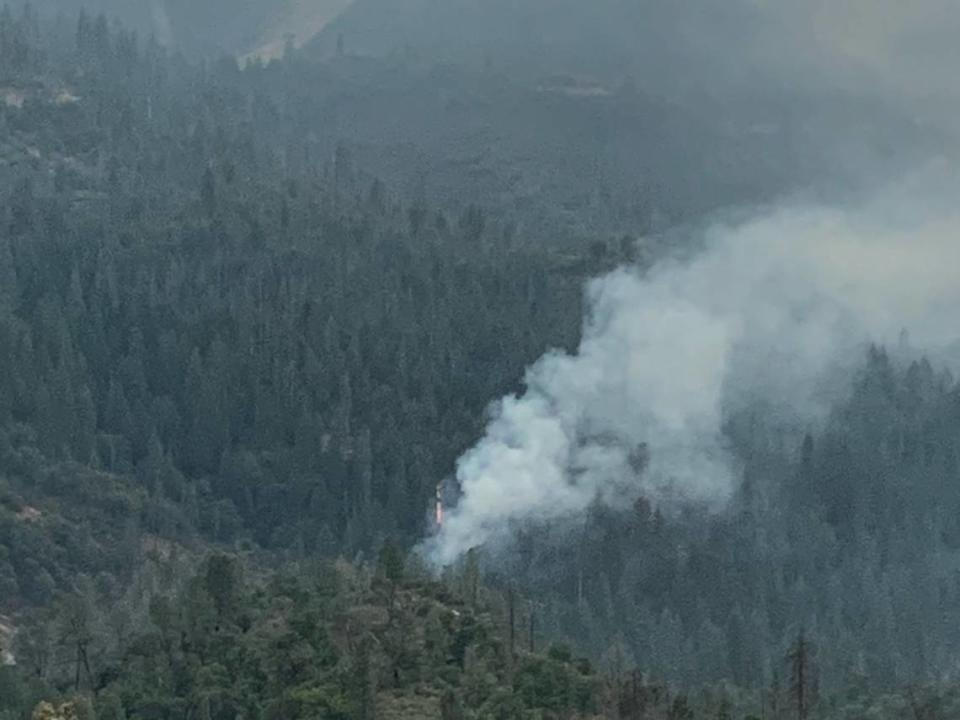
In their report, Forest Service investigators used photographs taken during the fire’s initial hours from the Big Creek helipad to help pinpoint the specific origin zone.
However, a zoom-in of one particular photo leads Young and Gillette to a different conclusion about where the fire started. In this photo the “candlestick” tree is clearly visible, engulfed by flame and practically glowing. However, the column of smoke isn’t emanating from the tree. Rather, most of the smoke rises from a good distance in front of the tree and down a rocky slope — at the location of the campfire circle they found.
“I can prove in court the fire did not start where they say it did,” said Young, who used both a laser pointer and signal mirror to pinpoint the fire’s origin in relation to the Big Creek helipad. “It’s obvious that snag is not where the smoke is coming from.”
‘Maybe lightning was what they wanted to find’
What’s driving Young and Gillette? Why don’t they (and others they’re working with) simply accept the Forest Service’s findings and move on?
Both men own property that burned in the fire and sustained personal financial losses. Still, they say the motivation isn’t money — though neither has ruled out a lawsuit if the evidence presents itself. More than anything, it’s about finding the truth about what caused the fire.
“For them not to find any of this evidence 300 feet from the tree they say was struck by lightning, it tells me something about the thoroughness of the investigation,” Gillette said. “Maybe the lightning was what they wanted to find, and then they were done.”
Young is more succinct: “I cannot accept government corruption.”
Going away quietly isn’t Young’s style. In recent weeks, the 64-year-old spoke to an FBI agent about inconsistencies in the Creek Fire report and passed out 400 copies of a four-page summary of his findings to Fresno County foothill and mountain residents. He also continues to investigate the initial response to the fire by both the Forest Service and sheriff’s office.
Young’s aim is to get the District Attorney’s Office to convene its own grand jury investigation.
“All we have to do is get between five and 10 people under oath,” he said. “Get them to tell the truth about what happened or not to speak at all.”
